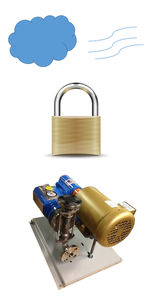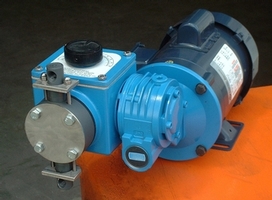There are many chemical metering related equipment available to consider in regards to your chemical injection application. Most of them being installed in line to assist the chemical metering pump.
Some of the more common chemical metering pump ancillary equipment are:
- Pulsation dampeners: which reduce the spikes in flow and pressure
- Relief valves: protect the chemical pump from dead heading
- Back pressure valves: to make sure the inlet and outlet check ball valves seat properly due to having some back pressure; as well as keeping liquid from siphoning through the solution head due to a the suction line having a higher pressure than the discharge side’s back pressure.
- Pressure gauges, flow meters, and so on.For this particular article we want to focus on foot valves and how AIR can be an enemy to diaphragm type metering pumps in regards to staying primed and reaching their rated flow rate capacities.
How does Air hinder chemical injection applications?
Terms to know:
Suction Lift: this exists when the source of the chemical supply is below the center of the metering pump’s solution head. Positive displacement type pumps are not often designed to overcome a suction lift without having the line manually primed. This article goes on to explain more.
Flooded Suction: this exists when the source of the chemical supply is even with or above the center of the chemical metering pump’s solution head. Flooded suctions are ideal for positive displacement diaphragm type metering pumps.
If there is air in the process line, and even more so when specifically in the suction line, diaphragm type chemical metering pumps can ‘air lock’. Air locking is when the chemical injection processes becomes stagnant, no output, due to a pocket of air. Diaphragm type metering pumps are not 100% air tight and
also not designed to pump air in general, making it nearly impossible to naturally overcome the pocket of air in order to prime up and start dosing the chemical again. In a previous blog we covered “air locking” extensively, check it out if you want to learn more about this issue with chemical metering pumps.
But for now, we want to focus specifically on the foot valve reduces the negative effects of air in a chemical metering process. This article will go on to discuss how this system component can help ensure your pump fires up and displaces the chemical every time, immediately on startup, when the metering pump is facing a suction lift set up. Foot valves can also help the system avoid losing prime during operation.
Foot Valves: when and why you should consider one, and how they work…
Chemical injection applications often use standard 55 gallon drums where the chemical solution is already mixed to appropriate concentration. In which case, pouring them into a holding tank to be the chemical metering pump’s supply source is often deemed redundant.
In these scenarios it is usually easiest for your operators to pump directly out of them, switching new chemical drums in and out as needed. When this is the set up for the suction side of the chemical metering pump, there is no easy way to provide the pump with a flooded suction end.
The metering pump will have to suck/lift the chemical up and out of the tank. If the line is not manually primed, that would mean the pump is trying to overcome pockets of air, and gravity. Not good.
So, a foot valve is needed in this scenario.
Foot valves: are simply check ball valves with a screen/filter on the open end. These keep your suction line full of liquid at all times, which assists with your chemical injection pump’s flow rate capacity. Foot valves keep your pump from struggling to maintain prime or even losing it all together, which means your chemical metering pump should always reach its rated capacity and maintain a consistent output.
Are there alternatives?
As alluded to earlier, the ideal set up for a chemical injection system is to provide the chemical metering pump with a flooded suction; this is most easily done using a separately bought holding tank(s). Madden designs and builds full chemical injection systems, where a self-draining tank with a mixer and flooded suction side are standard. If there is room in your budget, we strongly encourage you to look into a full chemical feed system for your chemical injection application.
Alas, as mentioned earlier, that isn’t always practical, and it certainly does add to the cost of your chemical injection package.
In which case, Foot valves = great, economical solution/alternative to full chemical feed system
- Use a rigid pipe or rigid tubing for the part of the suction line that will be inserted into the tank, as opposed to flexible hose. This ensures the foot valve will remain vertical, if it is shifted horizontally at all, the ball will not be seated firmly in the valve, potentially leading to liquid/chemical loss in the line.
- From the top of your rigid suction pipe/tube to the chemical metering pump’s inlet, you’ll want to either use flexible tube with enough length to be able to pull the rigid pipe/tube from the drum; or have a easily disassembled joint inserted somewhere in line that allows you to quickly disconnect the piping that is in the drum/tank. This will
 allow you to readily switch out chemical tanks as needed.
allow you to readily switch out chemical tanks as needed.
Conclusion
In most cases involving chemical metering, foot valves are going to be less than $50.00, and at that price we believe it is a great component to add to your chemical metering pump process. Accuracy and consistent repeatability in output are crucial to chemical injection applications; inconsistent output, or diminishing output over time can cause serious issues in your chemical metering process.
A foot valve is a great way to economically prevent these issues. So when you’re faced with a level suction line, or suction lift supply line, find a foot valve. You might be surprised at just how much head ache and trouble these simple devices will save you.
If you want to ask about a foot valve with your application, or need advice on any other metering pump accessory, please feel free to reach out to one of our Sales Reps near you, or directly to us.


 allow you to readily switch out chemical tanks as needed.
allow you to readily switch out chemical tanks as needed.
[…] Does your chemical metering pump need a foot valve? by Madden Pump 02/27/2018… Chemical metering pumps sometimes slowly lose their prime when pumping from the top of a 55 gallon drum. They also often need to be manually primed during start up. Click here to read how a foot valve can help solve these issues. […]